Wolf's Motorhome Modifications
... and Other Stuff
Amateur Radio Antennas and Station
The Home Station and Why HF Is VERY Important
When my kids were little, I watched them a lot. In fact, I
worked a permanent midnight shift and babysat until my wife got home from work. I
would then sleep and work all night. On top of my babysitting duties, I had days off
that would rotate through the week. One week I was off Monday and Tuesday. The
next I was off Tuesday and Wendsday, etc. I had three day weekends. It was a
lot more fun watching the kids while we were camping than it was sitting at home. I
began to take the kids camping with me while the wife, with her Saturday and Sunday off,
stayed home.
The wife is licensed. In order to keep in touch, we began
using packet radio to time-delay our messages. HF operation while camping became
very important. In fact, I am writing this from the Canyon Country Campground near
the Pennsylvania Grand Canyon after picking up messages from my wife (KA8ZVV) and daughter
(KC8KQP). Now that the kids are 15 and 16, they don't want to go camping
anymore. Now I have to keep in touch with them, too!
At home I operate a full MSYS software-based BBS. It is fully
linked and full forwarding. At one time, before the Internet, I had over 300 regular
users.
On HF, I have a scanning station that looks for people on various
frequencies. At the moment, it's scanning 20, 40 and 80 meters. I have it set
up to look for people on three frequencies on each band. I have quite a number of
Caribbean, Central and South American stations who use the HF port.
Antennas For Portable HF Operation
Many moons ago, I tried all kinds of antennas. My friend,
Mike, WA8BXN, stayed with a single configuration. Mike ran a standard Hustler mast
with standard Hustler radiators. When he got to a campground, he would mount the
antennas on the roof rack of his trailer. I tried dipoles, longwires, a five band
Hustler vertical. In all cases, if my setup beat Mike's, it was only by a couple of
S-units. The plain, simple fact was his was easier to put up, take down and operate
with.
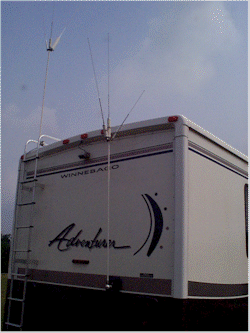 My first set of
Hustler for portable used a mount permanently screwed around the top of my ladder.
It worked great and as expected I was able to get home from anywhere at any time (barring
solar storms). Over time it aged and became quite corroded. The quick connect
mounts often would loose continuity.
My first set of
Hustler for portable used a mount permanently screwed around the top of my ladder.
It worked great and as expected I was able to get home from anywhere at any time (barring
solar storms). Over time it aged and became quite corroded. The quick connect
mounts often would loose continuity.
The current antenna set up involves three separate runs of RG-8x
snaked back to a luggage compartment. One is for HF mobile, one for HF portable and
one for VHF/UHF portable.
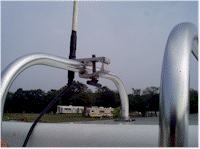 When I arrive, I pull out the Hustler HF mast with the coax
already attached. The mast terminates into a commercial clamp on mount that was
modified by using a better bolt. I attached one or three resonators (using the
available Hustler adapter) and climb the ladder to screw the mount down.
When I arrive, I pull out the Hustler HF mast with the coax
already attached. The mast terminates into a commercial clamp on mount that was
modified by using a better bolt. I attached one or three resonators (using the
available Hustler adapter) and climb the ladder to screw the mount down.
My last motorhome had an aluminum roof. I expected a dramatic
loss of signal due to my current fiberglass roof. No such loss was noted. Most
of my activity (and I work HF a lot when camping) is on 80 and 40.
Works great! Stays corrosion free.
A Caveat
Please! When someone on the newsgroups crabs that something
doesn't work, ask him if he ever had one and used it. Nine times out of ten you will
find the old windbag has absolutely NO experience. You'll know because if you ask if
they ever tried it they will quote theory instead.
Antennas for HF Mobile
I have my Mobile Worked All States on 80 and 40 so please, don't
preach to me about using Texas Bugcatchers or Screwdriver antennas. I know they work
great. I just don't need them. I would like to occasionally use them for
talking, a general CQ once in a while, listening to short-wave and monitoring the CB band
when traffic is backed up. Oh, and for checking the BBS when I'm parked at Wal-Mart
(poke-poke).
I currently use a through the wall mount of my own design. The
walls of a typical motorhome will only support a mobile antenna if you find and utilize a
steel beam. Rather than do that, I designed my mount to distribute the load of the
antennas over a large area of wall and thereby provide a solid mount.
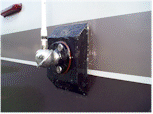
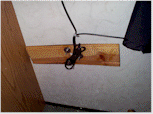 On the outside is a two by six treated piece of wood about eight
inches long. After cutting and drilling it for a Hustler stainless steel mobile
mount, I primed and painted it with marine-grade paint. I drilled four holes through
the wall. These came through in a closet where I used a piece of one by three lumber
to distribute the load from he STAINLESS STEEL bolts, nuts and washers. Again I used
GOOP adhesive. Take a cotton swab and swab GOOP into the holes to seal the walls of
the holes BEFORE you put the bolts through. Use some GOOP on the back of the two by
six.
On the outside is a two by six treated piece of wood about eight
inches long. After cutting and drilling it for a Hustler stainless steel mobile
mount, I primed and painted it with marine-grade paint. I drilled four holes through
the wall. These came through in a closet where I used a piece of one by three lumber
to distribute the load from he STAINLESS STEEL bolts, nuts and washers. Again I used
GOOP adhesive. Take a cotton swab and swab GOOP into the holes to seal the walls of
the holes BEFORE you put the bolts through. Use some GOOP on the back of the two by
six.
I picked up a ground from a nearby electrical socket. (You say
it won't work without a ground? Can't prove that in real-life,
here-it-is-and-it-works tests! There is enough metal in the steel framing of the
motorhome to provide the ground. A young-looking/acting representative at the
Dayton Hustler booth told me Hustlers wouldn't work on a motorhome!)
After all was set and I knew it worked by testing it, I literally
painted the whole caboodle with GOOP. This is not going to leak nor is it going to
peel.
I set the antennas (15, 20, 40 and 80 meters) and used some nylon
cord to provide a guy to the back.
Why So Low?
On my last motorhome, I had the same setup but had it mounted
high. I replaced four 80 meter resonators. Campground trees, low wires,
overhangs all do a number and loosen the metal where the whip goes into the
resonator. Mounting them high just isn't worth constantly changing the resonator.
Antennas for VHF/UHF Mobile
When I bought my current toad (a "toad" is a vehicle that
is towed behind a motorhome) I decided upon a Saturn station wagon. I needed the
wagon for the Irish Wolfhound. The Saturn can be towed four wheels down. The problem
with the Saturn is that the thing is plastic. The only metal in skin is the hood.
I bought it in October and didn't want to mess around punching a
hole in the roof. I was going to put a ground plane between the headliner and the
roof and run antenna(s) from there. I run 2, 1 1/4 and 3/4 meter mobile in all
vehicles. Instead, I picked up a Comet tri-band antenna and a Comet trunk lip
mount. The mount was put on the hood and I used that through the winter.
The car I traded was a Caravan. I had drilled three quarter
wave antennas into that roof and they worked very, very, very well. I was quite
surprised to find that my tri-bander on the Saturn worked nearly as well! So well,
in fact, that I bought one for the wife's car and the motorhome.
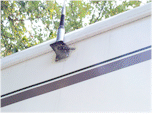
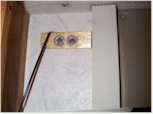 Larsen makes a 3/4 inch angle
bracket. I used that bracket and drilled into a cabinet to conceal the wire and
mounting bolts. The bracket allowed the stress of the antenna to be distributed to a
wide enough area. On the inside I used some one-by-two pieces of wood to take the
inside load and distribute it.
Larsen makes a 3/4 inch angle
bracket. I used that bracket and drilled into a cabinet to conceal the wire and
mounting bolts. The bracket allowed the stress of the antenna to be distributed to a
wide enough area. On the inside I used some one-by-two pieces of wood to take the
inside load and distribute it.
As always, I used a lot of GOOP. Prior to mounting, I swabbed
GOOP into all the holes to seal the inside of the hole. I then sealed the entire
assembly, inside and out, with GOOP.
Again, I know there's no ground. Sorry, it works very, very
well. Must be working against the steel frame. You do have a steel frame in
your RV, right?
VHF/UHF Portable
With the advent of micro-miniature radios like the Yaesu VX-1R, the
need for cross-band repeating becomes apparent. I recently picked up a Diamond dual
band single-piece base station antenna. I am experimenting with attaching that to
the third run of coax. I have about 100 feet free so that I can locate and pull that
antenna high into a tree or other structure.
In my last motorhome I had a dual-band Ringo mounted to a standard
RV antenna lift mechanism. WHAT A GREAT COMBINATION! All I had to do was
change the coax and crank the lift up. It worked GREAT. I might still do that
in the new motorhome.
The Station
The station is built so that it can be carried from the motorhome to
the shack at home and used there, too. The "stack" as I call it consists
of an AM/FM/Cassette on the top. Below that is a Kenwood TM-731A dual band radio for
144 and 440 MHz. An Icom IC-706 is used on HF. More on that later. A
small, meterless MFJ antenna tuner allows me to run about any antenna I desire. A
Kenwood 220 radio is next followed by a KAM all-mode controller.
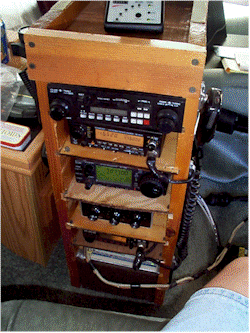 Below the radios in the same box are mounted five HIGH QUALITY
three inch speakers. Two are for the AM/FM/Cassette. One is for HF, the fourth
for 220 and the last for the dual bander. Having the proper speakers makes mobile
operation much more pleasant.
Below the radios in the same box are mounted five HIGH QUALITY
three inch speakers. Two are for the AM/FM/Cassette. One is for HF, the fourth
for 220 and the last for the dual bander. Having the proper speakers makes mobile
operation much more pleasant.
The radios are held in place by a piece of one inch by 1/8 aluminum
stock bent back to the console. A wing nut holds the radios to this retainer.
For Pactor, I use an older Radio Shack IBM/PC laptop, the
1500HD. I have cables that allow that to be positioned at a lounge chair for ease of
use when parked. When mobile I sometimes use my Hewlett-Packard HP-100 palmtop
computer.
When mobile, a Toshiba 440CDT sits atop the stack and is held with
Velcro. That is connected to power and the Tripmate GPS software to run DeLorme's
Street Atlas, Map-N-Go or TopoUSA. My Tripmate GPS receiver was mounted above the
driver's seat inside of a front cabinet. I found that by putting the receiver
against the front and all the way against the outer fiberglass roof, I could maintain a
green arrow even in dense forest. With the ceiling carpeting or any other item in
the way, it's effectiveness was diminished.
I installed a 12 foot nine conductor cable between where I have the
GPS mounted and the computer. By using DB-9s at both ends, I could leave that cable
yet use the Tripmate in other places.
Power for the Station
Power comes from two sources. First, and used most, eight
gauge wire runs from the battery (where it is fused) to an outlet installed in the front
of the motorhome. Go DIRECTLY to the battery with this lead. Sucking power
out of any old 12 volt line could give you converter hum or a higher voltage than you
would like your radio to see.
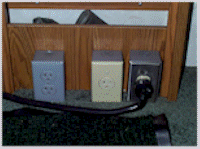 My
second power source is an Astron 35 amp power supply mounted in the basement. Should
the batteries be low, I can suck power out of the Astron. Eight gauge stranded is
again used to a second separate outlet.
My
second power source is an Astron 35 amp power supply mounted in the basement. Should
the batteries be low, I can suck power out of the Astron. Eight gauge stranded is
again used to a second separate outlet.
The radio stack is fed by a extension cord made from eight gauge
stranded. I have a longer cord ready should moving the stack outside be necessary.
The gray 110 volt outlet visible in the photo is discussed on the
"Winter Camping" page.
A note on the plugs I used. I used plugs that look like
this: (-.-). They are designed for 220 volt 15 amp service. NOTHING in
my life makes use of anything close to that plug. Yet, it's easy to find. I am
PERFECTLY comfortable in its use. If using a 220 volt plug for 12 volt DC bothers
you, use something else.
 My first set of
Hustler for portable used a mount permanently screwed around the top of my ladder.
It worked great and as expected I was able to get home from anywhere at any time (barring
solar storms). Over time it aged and became quite corroded. The quick connect
mounts often would loose continuity.
My first set of
Hustler for portable used a mount permanently screwed around the top of my ladder.
It worked great and as expected I was able to get home from anywhere at any time (barring
solar storms). Over time it aged and became quite corroded. The quick connect
mounts often would loose continuity. When I arrive, I pull out the Hustler HF mast with the coax
already attached. The mast terminates into a commercial clamp on mount that was
modified by using a better bolt. I attached one or three resonators (using the
available Hustler adapter) and climb the ladder to screw the mount down.
When I arrive, I pull out the Hustler HF mast with the coax
already attached. The mast terminates into a commercial clamp on mount that was
modified by using a better bolt. I attached one or three resonators (using the
available Hustler adapter) and climb the ladder to screw the mount down.
 On the outside is a two by six treated piece of wood about eight
inches long. After cutting and drilling it for a Hustler stainless steel mobile
mount, I primed and painted it with marine-grade paint. I drilled four holes through
the wall. These came through in a closet where I used a piece of one by three lumber
to distribute the load from he STAINLESS STEEL bolts, nuts and washers. Again I used
GOOP adhesive. Take a cotton swab and swab GOOP into the holes to seal the walls of
the holes BEFORE you put the bolts through. Use some GOOP on the back of the two by
six.
On the outside is a two by six treated piece of wood about eight
inches long. After cutting and drilling it for a Hustler stainless steel mobile
mount, I primed and painted it with marine-grade paint. I drilled four holes through
the wall. These came through in a closet where I used a piece of one by three lumber
to distribute the load from he STAINLESS STEEL bolts, nuts and washers. Again I used
GOOP adhesive. Take a cotton swab and swab GOOP into the holes to seal the walls of
the holes BEFORE you put the bolts through. Use some GOOP on the back of the two by
six.
 Larsen makes a 3/4 inch angle
bracket. I used that bracket and drilled into a cabinet to conceal the wire and
mounting bolts. The bracket allowed the stress of the antenna to be distributed to a
wide enough area. On the inside I used some one-by-two pieces of wood to take the
inside load and distribute it.
Larsen makes a 3/4 inch angle
bracket. I used that bracket and drilled into a cabinet to conceal the wire and
mounting bolts. The bracket allowed the stress of the antenna to be distributed to a
wide enough area. On the inside I used some one-by-two pieces of wood to take the
inside load and distribute it. Below the radios in the same box are mounted five HIGH QUALITY
three inch speakers. Two are for the AM/FM/Cassette. One is for HF, the fourth
for 220 and the last for the dual bander. Having the proper speakers makes mobile
operation much more pleasant.
Below the radios in the same box are mounted five HIGH QUALITY
three inch speakers. Two are for the AM/FM/Cassette. One is for HF, the fourth
for 220 and the last for the dual bander. Having the proper speakers makes mobile
operation much more pleasant. My
second power source is an Astron 35 amp power supply mounted in the basement. Should
the batteries be low, I can suck power out of the Astron. Eight gauge stranded is
again used to a second separate outlet.
My
second power source is an Astron 35 amp power supply mounted in the basement. Should
the batteries be low, I can suck power out of the Astron. Eight gauge stranded is
again used to a second separate outlet.